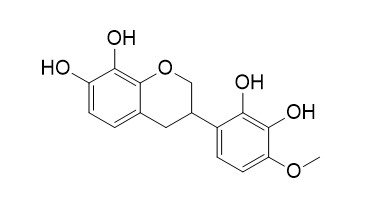3',8-DihydroxyvestitolCAS# 122587-87-5 |

Quality Control & MSDS
Package In Stock
Number of papers citing our products

| Cas No. | 122587-87-5 | SDF | Download SDF |
| PubChem ID | N/A | Appearance | Powder |
| Formula | C16H16O6 | M.Wt | 304.3 |
| Type of Compound | Flavonoids | Storage | Desiccate at -20°C |
| Solubility | Soluble in Chloroform,Dichloromethane,Ethyl Acetate,DMSO,Acetone,etc. | ||
| General tips | For obtaining a higher solubility , please warm the tube at 37 ℃ and shake it in the ultrasonic bath for a while.Stock solution can be stored below -20℃ for several months. We recommend that you prepare and use the solution on the same day. However, if the test schedule requires, the stock solutions can be prepared in advance, and the stock solution must be sealed and stored below -20℃. In general, the stock solution can be kept for several months. Before use, we recommend that you leave the vial at room temperature for at least an hour before opening it. |
||
| About Packaging | 1. The packaging of the product may be reversed during transportation, cause the high purity compounds to adhere to the neck or cap of the vial.Take the vail out of its packaging and shake gently until the compounds fall to the bottom of the vial. 2. For liquid products, please centrifuge at 500xg to gather the liquid to the bottom of the vial. 3. Try to avoid loss or contamination during the experiment. |
||
| Shipping Condition | Packaging according to customer requirements(5mg, 10mg, 20mg and more). Ship via FedEx, DHL, UPS, EMS or other couriers with RT, or blue ice upon request. | ||

3',8-Dihydroxyvestitol Dilution Calculator

3',8-Dihydroxyvestitol Molarity Calculator
| 1 mg | 5 mg | 10 mg | 20 mg | 25 mg | |
| 1 mM | 3.2862 mL | 16.4312 mL | 32.8623 mL | 65.7246 mL | 82.1558 mL |
| 5 mM | 0.6572 mL | 3.2862 mL | 6.5725 mL | 13.1449 mL | 16.4312 mL |
| 10 mM | 0.3286 mL | 1.6431 mL | 3.2862 mL | 6.5725 mL | 8.2156 mL |
| 50 mM | 0.0657 mL | 0.3286 mL | 0.6572 mL | 1.3145 mL | 1.6431 mL |
| 100 mM | 0.0329 mL | 0.1643 mL | 0.3286 mL | 0.6572 mL | 0.8216 mL |
| * Note: If you are in the process of experiment, it's necessary to make the dilution ratios of the samples. The dilution data above is only for reference. Normally, it's can get a better solubility within lower of Concentrations. | |||||

Calcutta University

University of Minnesota

University of Maryland School of Medicine

University of Illinois at Chicago

The Ohio State University

University of Zurich

Harvard University

Colorado State University

Auburn University

Yale University

Worcester Polytechnic Institute

Washington State University

Stanford University

University of Leipzig

Universidade da Beira Interior

The Institute of Cancer Research

Heidelberg University

University of Amsterdam

University of Auckland

TsingHua University

The University of Michigan

Miami University

DRURY University

Jilin University

Fudan University

Wuhan University

Sun Yat-sen University

Universite de Paris

Deemed University

Auckland University

The University of Tokyo

Korea University
- Theaflavanoside II
Catalog No.:BCN0744
CAS No.:943785-09-9
- 5,6,7,3',4',5'-Hexamethoxyflavanone
Catalog No.:BCN0743
CAS No.:74064-17-8
- Cuneataside C
Catalog No.:BCN0742
CAS No.:871720-16-0
- 10-O-trans-p-coumaroylscandoside
Catalog No.:BCN0741
CAS No.:870785-25-4
- Lariciresinol 4-O-glucoside
Catalog No.:BCN0740
CAS No.:143663-00-7
- 3'-O-Methylviolanone
Catalog No.:BCN0739
CAS No.:56973-42-3
- Methyl 2-hydroxy-3,4-dimethoxybenzoate
Catalog No.:BCN0738
CAS No.:6395-23-9
- Methylpicraquassioside B
Catalog No.:BCN0737
CAS No.:1443757-89-8
- Yinxiancaoside C
Catalog No.:BCN0736
CAS No.:1159908-74-3
- 3-O-Methylellagic acid 3'-O-alpha-rhamnopyranoside
Catalog No.:BCN0735
CAS No.:352280-34-3
- Bocconoline
Catalog No.:BCN0734
CAS No.:32906-88-0
- Isosilychristin
Catalog No.:BCN0733
CAS No.:77182-66-2
- Sativanone
Catalog No.:BCN0746
CAS No.:70561-31-8
- 10-O-trans-p-Feruloylscandoside
Catalog No.:BCN0747
CAS No.:1428268-72-7
- 2,3-Dehydrosilychristin
Catalog No.:BCN0748
CAS No.:57499-41-9
- Picraquassioside B
Catalog No.:BCN0749
CAS No.:169312-05-4
- Mucronulatol
Catalog No.:BCN0750
CAS No.:20878-98-2
- Tortoside B (Manglieside E)
Catalog No.:BCN0751
CAS No.:190655-17-5
- Caffeic acid 4-O-glucuronide
Catalog No.:BCN0752
CAS No.:1093679-71-0
- Ternstroside C
Catalog No.:BCN0760
CAS No.:914649-21-1
- Ternstroside A
Catalog No.:BCN0761
CAS No.:914649-13-1
- Ternstroside B
Catalog No.:BCN0762
CAS No.:914649-16-4
- Ternstroside D
Catalog No.:BCN0764
CAS No.:914649-26-6
- Ternstroside E
Catalog No.:BCN0765
CAS No.:914649-31-3
Molecular Docking Based Screening of Plant Flavonoids as Dengue NS1 Inhibitors.[Pubmed:25187688]
Bioinformation. 2014 Jul 22;10(7):460-5.
Dengue infection has turned into a serious health concern globally due to its high morbidity rate and a high possibility of increase in its mortality rate on the account of unavailability of any proper treatment for severe dengue infection. The situation demands an urgent development of efficient and practicable treatment to deal with Dengue virus (DENV). Flavonoids, a class of phytochemicals present in medicinal plants, possess anti-viral activity and can be strong drug candidates against viruses. NS1 glycoprotein of Dengue virus is involved in its RNA replication and can be a strong target for screening of drugs against this virus. Current study focuses on the identification of flavonoids which can block Asn-130 glycosylation site of Dengue virus NS1 to inhibit viral replication as glycosylation of NS1 is required for its biological functioning. Molecular docking approach was used in this study and the results revealed that flavonoids have strong potential interactions with active site of NS1. Six flavonoids (Deoxycalyxin A; 3,5,7,3',4'-pentahydroxyflavonol-3-O-beta-D-galactopyranoside; (3R)-3',8-Dihydroxyvestitol; Sanggenon O; Epigallocatechin gallate; Chamaejasmin) blocked the Asn-130 glycosylation site of NS1 and could be able to inhibit the viral replication. It can be concluded from this study that these flavonoids could serve as antiviral drugs for dengue infections. Further in-vitro analyses are required to confirm their efficacy and to evaluate their drug potency.


